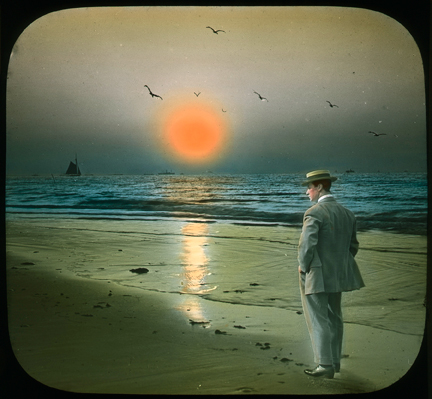In Context: "Daguerreotype to Digital"

I Am Longing for Tomorrow When I Think of Yesterday, ca. 1911. Hand colored glass positive, lantern slide by Crescent City Film Exchange, distributor. Courtesy the Historic New Orleans Collection.
Editor's Note
This winter, the Historic New Orleans Collection partnered with PhotoNOLA 2013 to host the exhibition, "Daguerreotype to Digital: A Presentation of Photographic Processes." The photographs, drawn from HNOC’s collection, represent developments in the medium from the 1840s to its current iterations. All the images were captured in and around New Orleans, providing a distinctly local perspective on the history of photography. For the first post in our In Context series, Pelican Bomb connects "Daguerreotype to Digital" to photography-related findings, in and out of town and on the web.
-
On the contemporary uses of photography, in a recent op-ed for the New York Times, contributor Susie Linfield argues that pictures released of corpses in Syrian jails are purposeful advertisements of government brutality. She implicates social media in the proliferation of these "perpetrator photographs," and contends that visual evidence is now more often used to affirm atrocities, rather than condemn them, making the Syrian civil war the first “postmodern conflict” in its use of images.
-
The question of what is behind (and outside the limitations of) the photograph was also a subject of discussion last week at The New Inquiry, when critic Jenna Brager reviewed Shawn Michelle Smith's new book, At the Edge of Sight: Photography and the Unseen. Excepting its last chapter on the visual evidence of torture at Abu Ghraib, the book focuses primarily on the late 19th century and how the nature of the photographic process at that time made it a purely professional endeavor, shaping what was historically seen and unseen.
-
Photography was still a technological (and artistic) novelty around the time of this country's Civil War, and its ability to convey the visual horror of battle changed the nature of warfare and documentary forever. View over 200 images in "Photography and the American Civil War." The show, which originated at the Metropolitan Museum of Art in New York, is on view at the New Orleans Museum of Art through May 4.
-
Minnesota-based photographer Andrew Moxom relishes the effort that goes into wet plate—or collodion—photography. He finds the Civil War-era process brings a special kind of relief from the pace and visual perfection of the digital age. This video from Minnesota Original provides an interesting look into what it's like dealing with archaic forms of chemical development today.
- And finally on the subject of process and experimentation, last week Slate published a glimpse of Bill Yates’ treasure trove of photographs of 1970s Florida teens. The images tell the story of Tampa’s roller rink scene, but even more revealing how a then budding photographer learned to master his equipment and navigate his young subjects.
Editor's Note
"Daguerreotype to Digital" on view until March 29, 2014 at the Historic New Orleans Collection's Williams Research Center (410 Chartres Street) in New Orleans.



